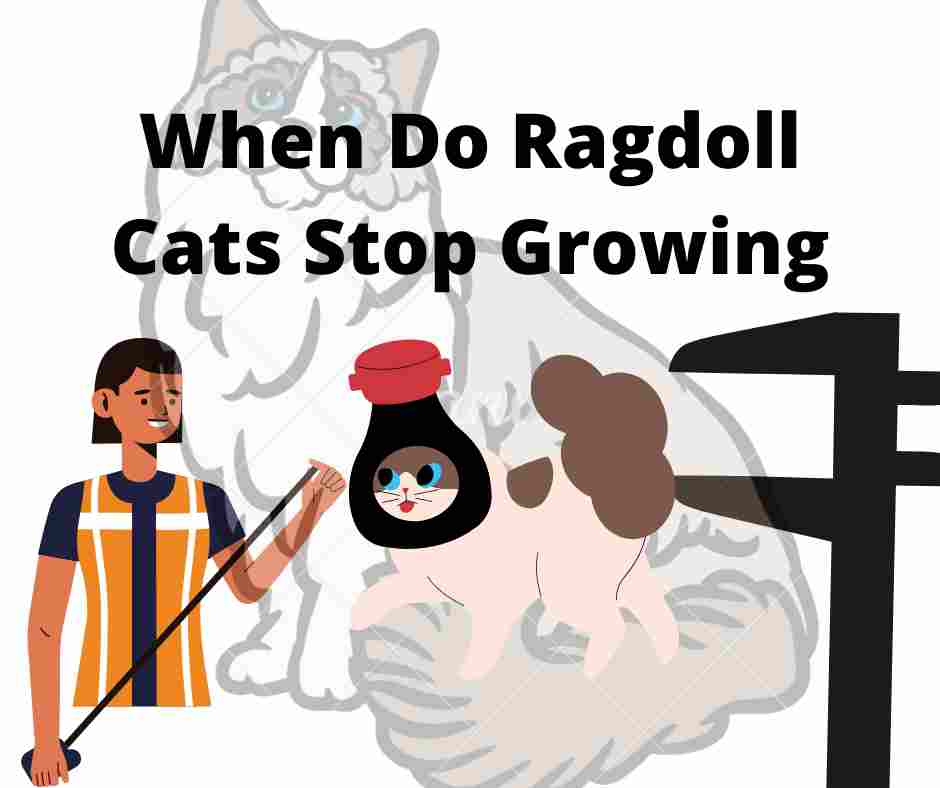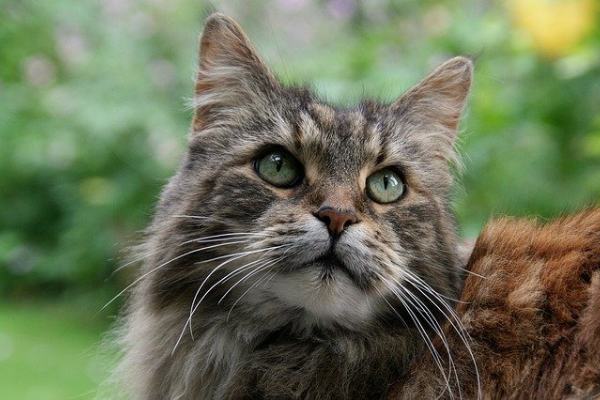When Do Ragdoll Cats Stop Growing: Growth Factors & More

Ragdoll cat owners always ask when do ragdoll cats stop growing!!! In this article, I will answer it and outline some common factors that influence their growth rate.
Ragdoll cats are a breed of cat with extreme physical floppiness, known for their gentle and docile behavior.
A major reason for the ragdoll’s floppy nature is that they are large-breed cats, which typically have a slower growth rate than other breeds.
If you have a Ragdoll cat, you know that they come in a variety of sizes and shapes. Some are large and fluffy, while others are small and slender.
When Do Ragdoll Cats Stop Growing
Ragdolls cease developing at the age of 3 to 4 years; at this point, all developmental activities in a ragdoll come to a halt, and only then can you claim your ragdoll is completely grown or has stopped growing.
Many things change around a ragdoll before this age, most notably the constant rise in coat color intensity, steady increase in weight, and a sluggish increase in height and length.
You may still be wondering when do ragdoll cats stop growing? Well, wonder no more!
The slow growth rate means that your ragdoll kitten will only weigh somewhere around 11 pounds by the time it reaches adulthood.
This puts them in the same weight range as an average domestic cat at 8-11 pounds. It also means that your ragdoll won’t reach full size until it is 3 or 4 years old.
Factors influencing the growth rate of a Ragdoll cat
When considering the growth of a Ragdoll cat there are some common factors you should consider which are as follows:
Lack of exercise
Ragdoll kittens require a lot of exercises, and it is critical for their growth that they get it.
Taking the time to play with them may make a huge impact since kittens develop faster when they are active.
So, to keep your Ragdoll healthy, play fetch with it every day. They also demand sufficient area to run and play, which should be considered before purchasing a huge cat.
I hear people say Ragdoll cats do not need exercise like other cats that is not true because ragdoll cats are prone to obesity.
They need exercise not just for the free flow of blood which enhances growth but also to burn excessive energy.
However, because they need exercise doesn’t mean you should over-exercise them.
Feeding the wrong food
Ragdolls have a dramatic growth spree, which needs to be supported by the correct intake of nutrients.
This means that they have to eat the right food in the right quantities to have the basis for their development.
Moreover, the vet will monitor the cat and set the correct food amount for the daily diet according to the kitten’s weight.
Aside from a correct diet, Ragdoll cats can benefit from special nutrient supplements to sustain their growth spree.
A veterinarian will determine the best possible supplement options for the kitten.
The Royal Canin Ragdoll Breed Adult Dry Cat Food is one of the best, if not the best. You can get it on Chewy or Amazon whichever one suits your cost.
Disease affects the growth of Ragdoll cats
This is an essential aspect that might influence your ragdoll’s development.
There are some health issues associated with Ragdoll cats, this can affect the growth of Ragdoll cats.
Ragdolls are a breed of cat that has been linked to a number of health concerns, all of which can have an impact on their growth.
Hairballs, which are produced by a lack of or irregular grooming of your ragdoll, are a common health concern we cause for our ragdolls.
When you don’t groom your ragdoll, he or she will groom themselves because the dead skin or hairs will drive them to scratch and lick the same hand they scratched with, resulting in the ingestion of their own hair.
Because they can’t digest their hair, they create hairballs, which can lead to other problems including vomiting and diarrhea.
During the time when your ragdoll is unwell, they may not be able to eat correctly, which will impair or postpone their growth.
So, schedule an appointment with your veterinarian if your ragdoll begins acting strangely; if you ignore it, your ragdoll’s growth may be harmed.
The runt of litter
A runt is a member of a group of animals that is substantially smaller or weaker than the rest.
A runt in a litter has apparent disadvantages as a result of its tiny size, including difficulty fighting with its siblings for survival and the possibility of rejection by its mother.
If your ragdoll cat is the runt of the litter, it will grow slower than expected and take longer to get to the maximum growth.
Parasite attacks affect the growth of Ragdoll cats
Parasites and worms affect the growth of Ragdoll cats, this can hind the steady growth and development of kittens.
Fleas, tapeworms, hookworms, ticks, mites, roundworms, etc. These parasites should be kept far away from your Ragdoll.
Make sure you deworm your Ragdoll from time to time and keep a tab on the skin of your Ragdoll when grooming.
Why is my ragdoll cat so small?
Your ragdoll cat is so little because it is either the runt of the litter, has a genetic mutation, has been impacted by the environment, is fed improperly, or is fed the incorrect food, or you are not patient with your ragdoll since ragdolls develop gradually and steadily.
The first thing to keep in mind is that ragdoll development can be gradual and constant, or it might be abrupt in rare circumstances.
Ragdoll growth spurts
Ragdoll growth spurts are most commonly caused by overfeeding or changing a ragdoll’s diet.
They can also occur when you adopt a new ragdoll into a new setting. Ragdoll growth spurts can also occur while a ragdoll is recuperating from a long-term illness.
Ragdolls normally go through growth spurts until they reach the age of four, at which point they have achieved their adult size.
Causes of Ragdoll growth spurts
Some spurts, however, are more prominent or visible for a variety of reasons:
Ragdoll recovering from a sickness
When a ragdoll is really ill, all growth and developmental activity stop for the time being; the ragdoll may even appear smaller and lose weight.
As time passes, you continue to provide medications as directed by the veterinarian, and when your ragdoll is clear of illness, it enters the recovery period.
During the healing stages, you utilize a variety of techniques to get your ragdoll back up and running, including supplementing its diet.
Then, after recovery, every growth activity continues, and because you boosted or stepped up your ragdoll meal during the healing stages, you will see notable ragdoll growth spurts, even in weight, between 2 and 4 months following recovery.
Genetics
The main reason for Ragdoll growth spurts is that they are normal and will last until the age of four when all growth and developmental activities cease.
If you pay attention to your ragdoll’s growth, you will often see these growth spurts, which are often more evident in male ragdolls than female ragdolls.
Despite the fact that these growth spurts are normal, there are still additional factors that might cause ragdoll growth spurts.
Environmental changes
When you receive a new ragdoll, its birth environment is modified, and depending on the new environment, your ragdoll’s growth may be slowed.
You’ll be in charge of your ragdoll’s adaptation to the new surroundings.
Because of environmental variables like temperature, development appears to halt throughout these transition periods.
When your ragdoll has settled down and, with your aid, has blended in with the surroundings. There is a noticeable ragdoll growth surge at this stage.
Changes in the quality of your Ragdoll cat food
You could not be witnessing your ragdoll’s development spurts because you’re feeding him low-quality food.
Consistent ragdoll development surges require high-quality food.
Do you believe you’ll notice a significant difference in ragdoll growth spurts if you adopt a ragdoll from a buddy who doesn’t care what he or she feeds the ragdoll, and then you start feeding the ragdoll a good and high-quality ragdoll food?
Ragdoll growth spurts are closely related to high-grade or specifically designed ragdoll food.
Ragdoll growth spurts can be caused by a variety of factors, including being the runt of the litter.
Ragdoll cat size
Let’s take a look at the complete size of an average or fully grown adult ragdoll to understand what we’re up against or what we’ve been discussing.
Ragdoll cat length
A fully developed male ragdoll can reach a height of 43–53 cm, while a fully grown female ragdoll can reach a height of 41–51 cm.
Ragdoll cat weight
A full-grown male ragdoll may weigh somewhere between 5.4 and 10 kg, whereas a full-grown female ragdoll can weigh anywhere between 3.6 and 7.8 kg. The feeding schedule, on the other hand, might alter the weight of both male and female ragdolls.
Ragdoll cat height
A full-grown male ragdoll can reach a height of 23 – 28 cm, while a full-grown female ragdoll can reach a height of 21 – 26 cm. Ragdolls are a big breed of cat that can reach a height of 23 – 28 cm.
More interesting topics:
Final thoughts
Ragdolls are known for their temperament, which is described as sweet and placid.
They’re also typically large, weighing between 10-20 pounds and standing up to two feet in height.
A question often asked by those considering adopting a Ragdoll is “How big do Ragdolls get?” The answer is that they reach their full-size potential at about two years old.
Until then, there can be some considerable variation in size from kittenhood to adulthood.
Read more on how to care for a Ragdoll cat.


![Will Beagles Return Home If Lost [Answered] Will Beagles Return Home](https://petcreeks.com/wp-content/uploads/2021/04/beagle-5964194_640.jpg)



![Will My Cat Come Back If I Let Him Outside [Useful Hints] Will My Cat Come Back If I Let Him Outside](https://petcreeks.com/wp-content/uploads/2023/10/pexels-dids-1383812.jpg)